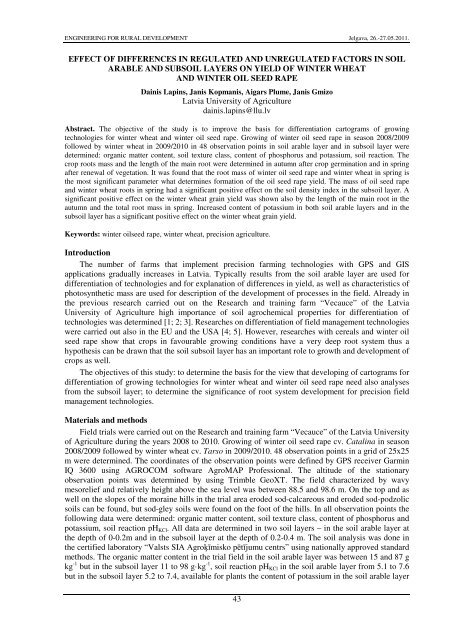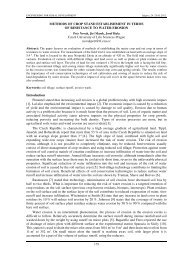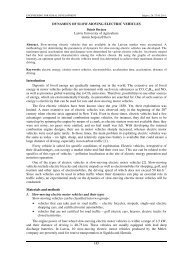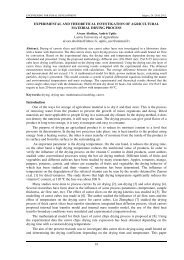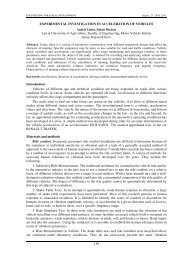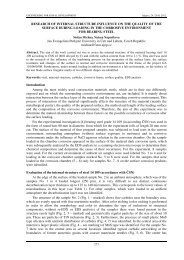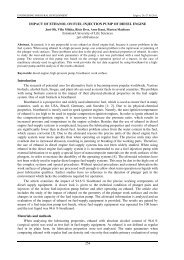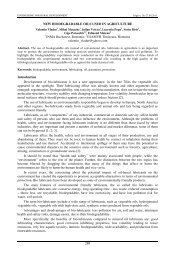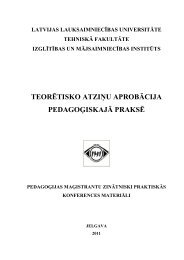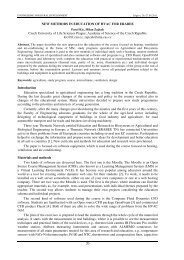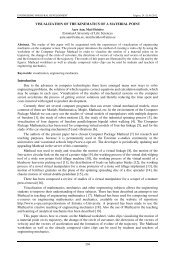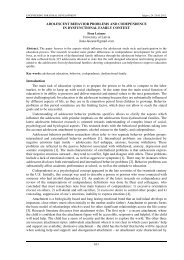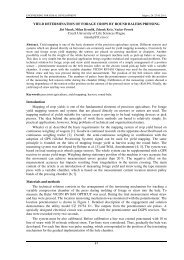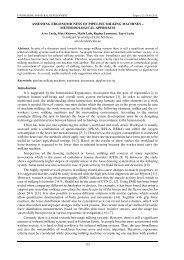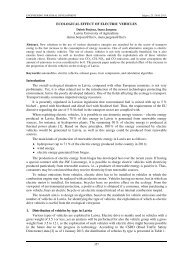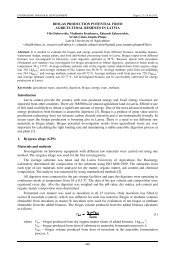Dainis Lapins, Janis Kopmanis, Aigars Plume, Janis Gmizo Latvia ...
Dainis Lapins, Janis Kopmanis, Aigars Plume, Janis Gmizo Latvia ...
Dainis Lapins, Janis Kopmanis, Aigars Plume, Janis Gmizo Latvia ...
You also want an ePaper? Increase the reach of your titles
YUMPU automatically turns print PDFs into web optimized ePapers that Google loves.
ENGINEERING FOR RURAL DEVELOPMENT Jelgava, 26.-27.05.2011.<br />
EFFECT OF DIFFERENCES IN REGULATED AND UNREGULATED FACTORS IN SOIL<br />
ARABLE AND SUBSOIL LAYERS ON YIELD OF WINTER WHEAT<br />
AND WINTER OIL SEED RAPE<br />
<strong>Dainis</strong> <strong>Lapins</strong>, <strong>Janis</strong> <strong>Kopmanis</strong>, <strong>Aigars</strong> <strong>Plume</strong>, <strong>Janis</strong> <strong>Gmizo</strong><br />
<strong>Latvia</strong> University of Agriculture<br />
dainis.lapins@llu.lv<br />
Abstract. The objective of the study is to improve the basis for differentiation cartograms of growing<br />
technologies for winter wheat and winter oil seed rape. Growing of winter oil seed rape in season 2008/2009<br />
followed by winter wheat in 2009/2010 in 48 observation points in soil arable layer and in subsoil layer were<br />
determined: organic matter content, soil texture class, content of phosphorus and potassium, soil reaction. The<br />
crop roots mass and the length of the main root were determined in autumn after crop germination and in spring<br />
after renewal of vegetation. It was found that the root mass of winter oil seed rape and winter wheat in spring is<br />
the most significant parameter what determines formation of the oil seed rape yield. The mass of oil seed rape<br />
and winter wheat roots in spring had a significant positive effect on the soil density index in the subsoil layer. A<br />
significant positive effect on the winter wheat grain yield was shown also by the length of the main root in the<br />
autumn and the total root mass in spring. Increased content of potassium in both soil arable layers and in the<br />
subsoil layer has a significant positive effect on the winter wheat grain yield.<br />
Keywords: winter oilseed rape, winter wheat, precision agriculture.<br />
Introduction<br />
The number of farms that implement precision farming technologies with GPS and GIS<br />
applications gradually increases in <strong>Latvia</strong>. Typically results from the soil arable layer are used for<br />
differentiation of technologies and for explanation of differences in yield, as well as characteristics of<br />
photosynthetic mass are used for description of the development of processes in the field. Already in<br />
the previous research carried out on the Research and training farm “Vecauce” of the <strong>Latvia</strong><br />
University of Agriculture high importance of soil agrochemical properties for differentiation of<br />
technologies was determined [1; 2; 3]. Researches on differentiation of field management technologies<br />
were carried out also in the EU and the USA [4; 5]. However, researches with cereals and winter oil<br />
seed rape show that crops in favourable growing conditions have a very deep root system thus a<br />
hypothesis can be drawn that the soil subsoil layer has an important role to growth and development of<br />
crops as well.<br />
The objectives of this study: to determine the basis for the view that developing of cartograms for<br />
differentiation of growing technologies for winter wheat and winter oil seed rape need also analyses<br />
from the subsoil layer; to determine the significance of root system development for precision field<br />
management technologies.<br />
Materials and methods<br />
Field trials were carried out on the Research and training farm “Vecauce” of the <strong>Latvia</strong> University<br />
of Agriculture during the years 2008 to 2010. Growing of winter oil seed rape cv. Catalina in season<br />
2008/2009 followed by winter wheat cv. Tarso in 2009/2010. 48 observation points in a grid of 25x25<br />
m were determined. The coordinates of the observation points were defined by GPS receiver Garmin<br />
IQ 3600 using AGROCOM software AgroMAP Professional. The altitude of the stationary<br />
observation points was determined by using Trimble GeoXT. The field characterized by wavy<br />
mesorelief and relatively height above the sea level was between 88.5 and 98.6 m. On the top and as<br />
well on the slopes of the moraine hills in the trial area eroded sod-calcareous and eroded sod-podzolic<br />
soils can be found, but sod-gley soils were found on the foot of the hills. In all observation points the<br />
following data were determined: organic matter content, soil texture class, content of phosphorus and<br />
potassium, soil reaction pH KCl . All data are determined in two soil layers – in the soil arable layer at<br />
the depth of 0-0.2m and in the subsoil layer at the depth of 0.2-0.4 m. The soil analysis was done in<br />
the certified laboratory “Valsts SIA Agroķīmisko pētījumu centrs” using nationally approved standard<br />
methods. The organic matter content in the trial field in the soil arable layer was between 15 and 87 g<br />
kg -1 but in the subsoil layer 11 to 98 g·kg -1 , soil reaction pH KCl in the soil arable layer from 5.1 to 7.6<br />
but in the subsoil layer 5.2 to 7.4, available for plants the content of potassium in the soil arable layer<br />
43
ENGINEERING FOR RURAL DEVELOPMENT Jelgava, 26.-27.05.2011.<br />
73 to 344 mg·kg -1 but in the subsoil layer 85 to 228 mg·kg -1 , available for plants the content of<br />
phosphorus in the soil arable layer 76 to 282 mg·kg -1 but in the subsoil layer 99 to 310 mg·kg -1 . The<br />
soil texture class was determined by using the field method and described as the content of physical<br />
clay [6; 7]. The obtained data of the organic matter content and granulometric composition were used<br />
to calculate the index of soil density. The calculations are based on coherences between the soil bulk<br />
density, organic matter content and soil texture classes [6].<br />
The yield of winter oil seed rape was harvested with the harvester Claas Lexion 420 to create the<br />
yield map using AGROCOM software, but the yield of winter wheat was determined by taking 3 plant<br />
samples in each observation point from 0.1 m 2 area. The determination of the winter wheat yield<br />
formatting elements was done at the same time.<br />
The crop root mass and the length of the main root were determined in autumn after crop<br />
germination and in spring after renewal of vegetation. 3 oil seed rape plants and 10 winter wheat<br />
plants were taken in autumn at growth stage BBCH 11-13 and in spring at BBCH 21-22 for oil seed<br />
rape and at BBCH 25-29 for wheat.<br />
Table 1<br />
Average day and night temperature and precipitation during growing season<br />
in 2009-2010 and in comparison with long term average<br />
Month<br />
Long-term<br />
average<br />
temperature<br />
Temperature, ºC<br />
2009 2010<br />
Long-term<br />
average<br />
precipitation<br />
Precipitation, mm<br />
2009 2010<br />
May 11.2 11.0 11.9 43 18.0 72.6<br />
June 15.1 13.7 14.6 51 95.0 37.8<br />
July 16.6 17.1 20.8 75 136.0 131.8<br />
August 16.0 15.8 18.2 75 38.8 133.4<br />
September 11.5 12.9 10.8 59 39.8 78.0<br />
The meteorological conditions in the trial years were characterized by the increased amount of<br />
precipitation in both summers of 2009 and 2010 but the temperatures, especially in July 2010, were<br />
highly above the long term observed (Table 1).<br />
The data analysis was performed using mathematical descriptive statistics and correlation<br />
analysis.<br />
Results and discussion<br />
Analysis of factors affecting the yield of winter oil seed rape<br />
It was found that the root mass of winter oil seed rape in spring is the most significant parameter<br />
(r yx = 0.4521, p < 0.001) that determines formation of the oil seed rape yield. Also the length of the<br />
main root and root mass in autumn showed a significant positive effect (r yx = 0.2863 and r yx = 0.3130<br />
respectively, p < 0.05) correlated with the winter oil seed rape yield. In its turn, the mass of the oil<br />
seed rape roots in spring had a significant positive (r yx = 0.3263, p < 0.05) effect on the soil density<br />
index in the subsoil layer at the depth of 0.2-0.4 m. The biomass of oil seed rape plants, which had<br />
high positive and significant (p < 0.001) correlation with the yield, showed also positive correlation<br />
with the soil density index in the subsoil layer (r yx = 0.2837, p < 0.05) as well as in the soil arable layer<br />
(r yx = 0.2248, p < 0.05).<br />
It was found that increased content of K 2 O in the arable as well as in the subsoil layer has a<br />
positive, but insignificant (p > 0.05) effect to the winter oil seed rape yield, but soil reaction pH KCl<br />
showed a significant (p < 0.01) negative effect (Table 2). This can be explained by the significant<br />
potassium content and soil pH KCl antagonism in both soil layers.<br />
The winter oil seed rape yield was significantly (p < 0.05) lower if compared with the average<br />
values when the soil density index in both soil and subsoil layers was below 1.3. Significantly<br />
(p < 0.05) higher oil seed rape yields (3.68 - 3.95 t·ha -1 ) were harvested in the field areas, where the<br />
soil density index in both the arable and subsoil layer was between 1.3 and 1.49. Results allow<br />
44
ENGINEERING FOR RURAL DEVELOPMENT Jelgava, 26.-27.05.2011.<br />
concluding that soil density index can be used as a parameter for differentiation of field management<br />
systems.<br />
Table 2<br />
Yield of winter oil seed rape, t·ha -1 , in dependence on soil pH KCl<br />
and content of K 2 O, mg·kg -1 , in soil arable and subsoil layers<br />
Soil layers Soil reaction pH KCl Content of K 2 O, mg·kg -1 Oil seed rape yield, t·ha -1 Sx<br />
from 73 to 156 3.75 0.11<br />
Arable from 5.1 to 6.4<br />
from 157 to 344 3.58 0.11<br />
layer<br />
from 73 to 156 2.99 0.20<br />
from 6.6 to 7.6.<br />
from 157 to 344 3.38 0.20<br />
from 85 to 165 3.69 0.11<br />
Subsoil from 5.2 to 6.5<br />
from 166 to 228 3.66 0.12<br />
layer<br />
from 85 to 165 3.04 0.22<br />
from 6.6 to 7.4<br />
from 166 to 228 3.15 0.21<br />
The winter oil seed rape yield was significantly (p < 0.05) lower if compared with the average<br />
values when the soil density index in both soil and subsoil layers was below 1.3. Significantly<br />
(p < 0.05) higher oil seed rape yields (3.68 - 3.95 t·ha -1 ) were harvested in the field areas, where the<br />
soil density index in both the arable and subsoil layer was between 1.3 and 1.49. The results allow<br />
concluding that the soil density index can be used as a parameter for differentiation of field<br />
management systems.<br />
Table 3<br />
Effect of soil density index in soil arable and subsoil layers<br />
to winter wheat yield, t·ha -1 Yield, t·ha -1<br />
Soil density index<br />
in arable layer<br />
Soil density index in<br />
subsoil layer<br />
On average<br />
in group<br />
On average in<br />
all area + S x<br />
< 1.3 < 1.3 4.11 6.27 5.90<br />
from 1.31 to 1.49<br />
< 1.3 6.35 6.27 5.90<br />
from 1.31 to 1.49 5.81 6.27 5.90<br />
> 1.50 6.64 6.27 5.90<br />
> 1.50<br />
from 1.31 to 1.49 7.53 6.27 5.90<br />
> 1.50 6.66 6.27 5.90<br />
On average in<br />
all area – S x<br />
Analysis of factors effecting yield of winter wheat<br />
The data analysis showed significant (p < 0.001) positive correlation between the winter wheat<br />
grain yield and thousand grain mass, and as well the number of productive stems. A significant<br />
(p < 0.05) positive effect on the winter wheat grain yield was shown also by the length of the main<br />
root in the autumn and the total root mass in spring. A positive effect of the soil density index in both<br />
the soil arable layer and in the subsoil layer on the winter wheat yield was explicit with a very high<br />
probability (p < 0.001). The soil density indexes showed that this parameter can be successfully used<br />
for soil tillage differentiation (Table 3).<br />
Table 4<br />
Effect of potassium content to winter wheat grain yield, t·ha -1<br />
Content of potassium, mg·kg -1<br />
Yield<br />
in arable layer in subsoil layer t·ha -1 S x<br />
from 73 to 156 from 85 to 165 5.40 0.34<br />
from 166 to 228 6.60 0.30<br />
from 157 to 344 from 85 to 165 5.86 0.35<br />
from 166 to 228 6.58 0.27<br />
45
ENGINEERING FOR RURAL DEVELOPMENT Jelgava, 26.-27.05.2011.<br />
Increased content of potassium in both the soil arable and subsoil layer has a significant (p


